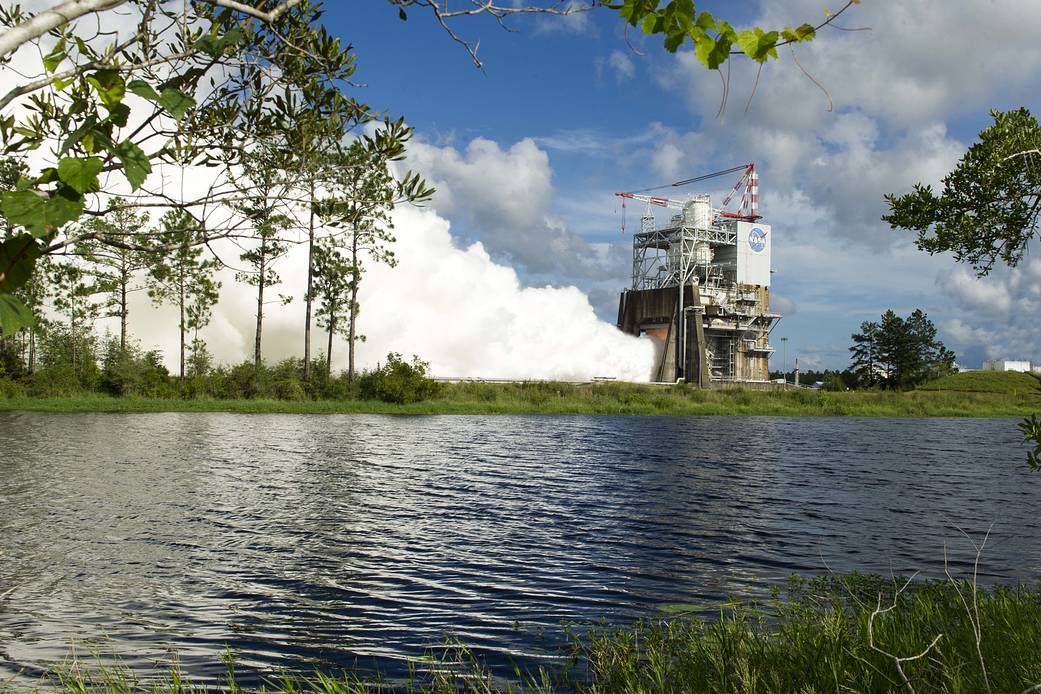NASA engineers successfully conducted a development test of the RS-25 rocket engine Thursday, Aug. 18 at NASA’s Stennis Space Center near Bay St. Louis, Miss. The RS-25 will help power the core stage of the agency’s new Space Launch System (SLS) rocket for the journey to Mars. A variety of NASA officials and contractor representatives, as well as social and traditional media members, gathered to watch the 420-second test of RS-25 engine No. 0528. NASA is developing the SLS to send humans further into deep space than they have ever traveled, including on the journey to Mars. Prior to the test at Stennis, NASA hosted social and traditional media at its nearby Michoud Assembly Facility in New Orleans on Wednesday afternoon and Thursday morning, providing exhibits, tours and briefings on progress in the journey to Mars. More than 130 media members participated in the event. With the RS-25 test at Stennis, participants viewed evidence of the agency’s progress firsthand. The new SLS rocket will be powered at launch by four RS-25 engines like the one tested, firing in conjunction with a pair of solid rocket boosters. NASA has conducted tests of the new booster at Orbital ATK’s test facilities in Promontory, Utah, while all RS-25 developmental and flight engine tests will be conducted on the A-1 Test Stand at Stennis. The tests are critical to ensure the RS-25 engines will perform as needed. RS-25 engines previously were used as space shuttle main engines, powering 135 missions to low-Earth orbit from 1981 to 2011. Although extensively tested for those flights, the engines now must fire at higher performance levels to power the SLS. The development tests at Stennis are providing key data on engine performance. The tests also are collecting data on the performance of a new engine controller unit, which controls internal engine functions during operation and enables proper communication between the SLS and the engine. During the test, the engine was run through a range of varying conditions and operating parameters. For instance, operators used an extended low-flow chill down process for the engine prior to the test and also experimented with a high-pressure start process. A special engine controller wiring configuration was tested, and the engine was fired at ranges of 80 to 111 percent power during the test. Test data on engine and controller performance was provided by the facility team at twice the normal rate. The test was conducted by a team of NASA, Aerojet Rocketdyne and Syncom Space Services personnel. Aerojet Rocketdyne is NASA’s prime contractor for developing and building RS-25 engines. Syncom Space Services is the agency’s prime contractor for maintenance of Stennis facilities and operations. This latest test marks the third in a six-test developmental series. NASA tested RS-25 engine No. 2059 in March for use as a flight engine on the second integrated test flight of SLS with the agency’s Orion spacecraft, known as Exploration Mission-2, which will carry a crew aboard the space capsule for the first time. The latest developmental series of tests began with a July 14 firing, followed by a July 29 test. Future tests are scheduled for this fall and also will focus on gathering performance data on the engine and its new controller. NASA also continues to prepare for testing the SLS core stage that will fly on the rocket’s first test flight in 2018. Plans call for installing the stage onto the modified B-2 Test Stand at Stennis and firing its four RS-25 engines simultaneously, just as during an actual launch.
3 min read



























